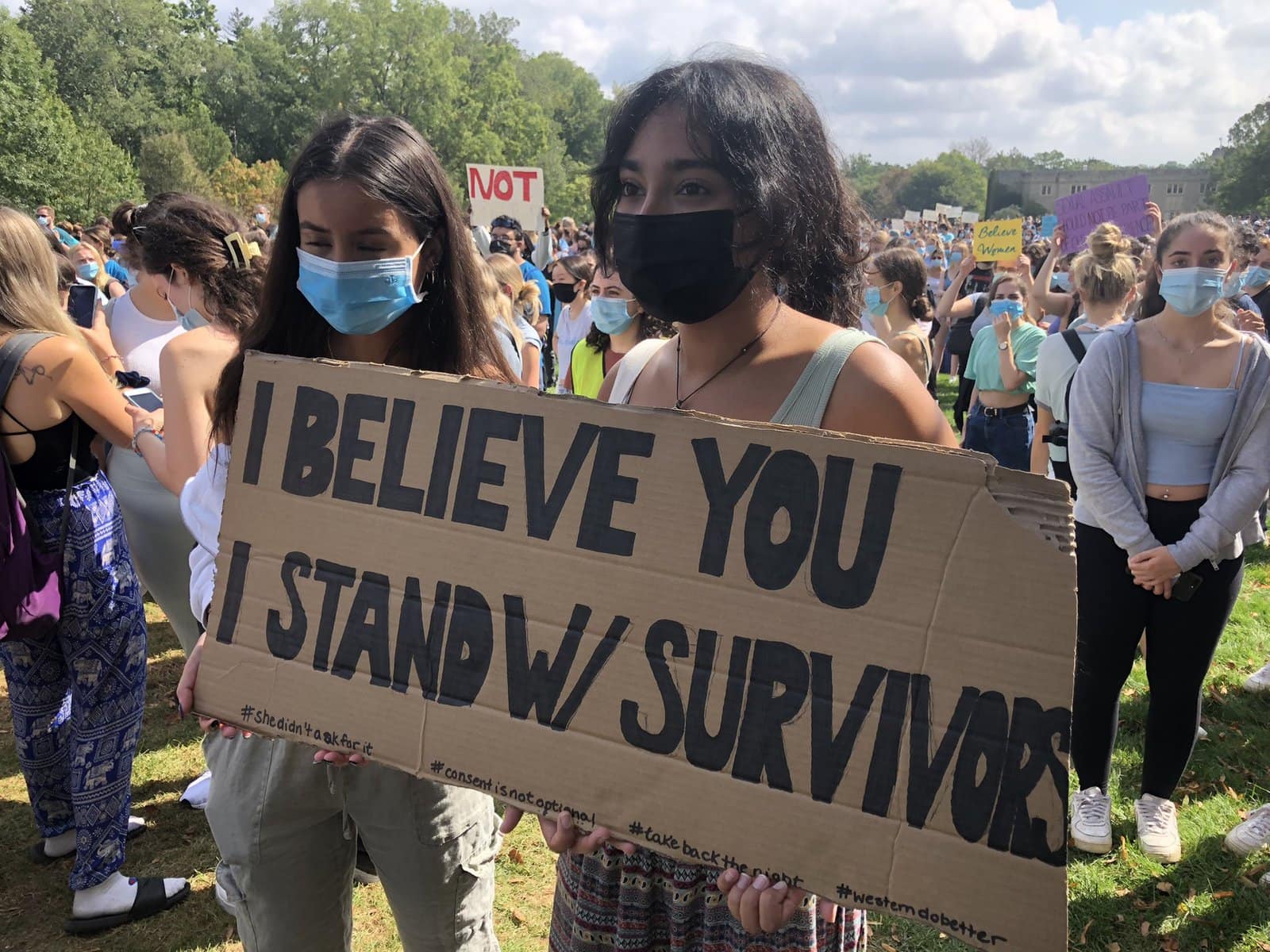
KJIPUKTUK (Halifax) – By way of introduction: I was a professor at Saint Mary’s University in Halifax for 17 years. I taught in the Management Dept. of the Sobey School of Business. I have firsthand experience with the misogynist culture in the university. I’ve written this post because the rape culture, exposed at Western University last week, exists in Canadian universities. I’m looking at it in the context of Saint Mary’s University.
Y is for your sister
O is for oh so tight
U is for underage
N is for no consent
G is for grab that ass
SMU boys we like them young
This freshman chant went viral the first week of September 2013, when leaders of Frosh student week coached first year students at Saint Mary’s University in Halifax with these catchy words. Not special to Saint Mary’s University (SMU) students, this little jingle was meant to boost student spirit—despite its focus on degrading women and promoting nonconsensual sex. Four hundred 18-19 year old students (women too) sang this rape chant in the university’s gymnasium.
That same year, members of the SMU football team (the Huskies) were caught tweeting hate, racism and sexism online. Despite being “outed”, some players continued to tweet messages including this one: “That bitch bit me last night. Hope your[sic] dead in a ditch, you are scum.” As well as “Cut your face off and wear it while I’m fucking your mother” and “Bitch, get on your knees.” What about this retweet from another twitter account? “School is like a boner, it’s long and hard unless you’re Asian”? Media reports at the time said that the university reacted by suspending between six and ten players from the Huskies team – but not from the university.
That was 8 years ago.
Just this week the media carried reports that more than 30 female students at Western University in London, Ont. were sexually assaulted or raped in the first week of school. The student council leaders, and Western’s president don’t deny it.
It’s probably more than 30 women students now — two weeks into the term. And we know this happens on every campus in Canada.
Farrah Khan, manager of the Office of Sexual Violence Support and Education at XX University (formerly Ryerson University in Toronto), warned that 71% of students experienced or witnessed unwanted sexualized behaviour in 2019. Indeed, the Statistics Canada Survey on Individual Safety in Post secondary Student Population (2020) reveals a whole minefield of facts including these:
- 11% of post-secondary school women experienced at least one sexual assault during their previous year on campus
- 19% of women who were sexually assaulted said the non-consensual assault happened after they had first agreed to another form of sexual activity.
- 45% of students who identify as women, and 32% of those who identify as men experience at least one unwanted sexual behaviour in the context of their time at university or college
- 80% of women who experienced unwanted sexual behaviour said the perpetrator was a fellow student
- Only about 8% of women and 6% of men who experienced unwanted sexual behaviour ever reported it to a professor, or the university administration, or to security.
We also know that misogyny, racism, bullying and more are bound up in the culture of most universities. But why is that?
In the chapter I wrote “Rape Chant at Sant Mary’s University” in the 2017 book Sexual Violence at Canadian Universities, I state there are three phenomena that converged at Saint Mary’s to open the door to sexim and misogyny:
1. The business school culture
For the last 30 years business schools are “vanguard” faculties in many universities. By “vanguard” I mean the universities “crown” business schools as the biggest and/or the leading faculties. This coincides with the unbridled growth of neo-liberalism and the rise of the “market” and consumerism which govern most people’s lives.
Business schools teach students how to make profits and prop up the capitalist system. Lately some business schools specialize in promoting the “entrepreneurial” culture in which there is little to no emphasis on the common good, group solutions or questioning authority. Renowned McGill business studies professor Henry Mintzberg calls business school trained MBAs “a menace to society.” Business school education contributes to a competitive and winner takes all type of thinking, or “pedagogy of the privileged.”
The role of women in the business world is played down. In 2019, 24.5% of Financial Post top 500 corporate board seats were held by women — up from 22% in 2017. A BNN-Bloomberg report found that there were only 2 women CEOS in the top 100 most influential companies within the S&P/TSX Composite Index.
Nowhere are there any target figures or quotas to enfranchise more womene. The fact that women are still under-representd on boards and in public appointments demonstrates that business education’s message to women students is: you probably won’t make it to the top. In fact, women are second rate.
2. The sports culture
Many universities are known for their sports teams; to be frank, sports teams are a tool used to recruit more students. Widespread academic research suggests that male varsity teams “may be consistent with pro-sexual violence attitudes and a culture that promotes, or at least does not discourage, sexualized violence.” Anthropologist Peggy Reeves-Sanday echoes this when she writes that key elements of sexual assault on campus (also called rape culture are “sex segregation, tolerance for violence and male dominance.” The established link between varsity sport and sexual violence is concerning because many universities have a dozen or more teams.
3. The drinking culture
Drinking is a big part of most students’ culture and socializing. Drinking is often allowed in student residence rooms and at the student bars on campuses. Evidence is that the vast majority of sexual assault cases involve alcohol. One estimate is that almost 90% of Canadian university students drink alcohol, while 43% report drinking at least once a month. Underage drinking is common. Binge drinking by students, and mixing alcohol with highly caffeinated energy drinks can lead to more “negative alcohol related consequences” than using alcohol alone.
Researchers note that “When combined, the use of alcohol and/or drugs not only increases the likelihood of a sexual assault occurring but also works to decrease the perpetrator’s feelings of responsibility.”
The prevalence of date rape drugs – drugs used to spike women’s drinks in bars and at parties– means women are left totally incapacitated and out cold. Some women find themselves in their own or an empty hotel room when they finally wake up hours later. One emergency room doctor at the QEII hospital in Halifax estimated he sees about two women in the ER who were subject to date rape drugs every month. He calculated that meant there were likely more than 20 cases of women who did not go to emergency. With 30 ER doctors on duty, that figure could be as high 600 cases in a month.
Every year the public waits to find out how serious sexual assault is in Frosh week activities. This year, the first shoe dropped at Western University with the news of sexual assaults on at least 30 young women over the first few days of classes. When will the other shoe drop? When will other universities be named – as doing little to nothing though every year women students and vulnerable students get attacked most often by male students. Universities’ chief line of defense is that they will educate, warn the students who live in on-campus residences, hire residence monitors and offer bystander training. But bystander training has been a “thing” for nearly a decade. Yet we have not seen an appreciable decrease in sexual violence on campuses. Why is that? One reason could be bystander training is based on techniques to “change the channel” rather than confront the issue head-on. For example, in by-stander training, people are taught to distract the perpetrator, or remove the person at risk. By following the 3 D’s (Direct, Distract, Delegate) to safely intervene in a potentially violent situation, the technique is meant to de-escalate the situation. But the situation still exists. The harasser, or the perpetrator, will just find another victim, and go after her.
It is the culture that has to change. That change means there can be no tolerance for misogyny and devaluation of women in society as a whole.
Judy Haiven is on the steering committee of Equity Watch, an organization that fights discrimination, bullying and racism in the workplace. Contact her at equitywatchns@gmail.com
Check out our new community calendar!
With a special thanks to our generous donors who make publication of the Nova Scotia Advocate possible.
Subscribe to the Nova Scotia Advocate weekly digest and never miss an article again. It’s free!



